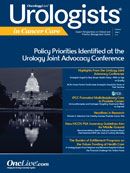Publication
Article
Oncology Live Urologists in Cancer Care®
Downregulated Oncogene Raises OS in Obese Patients With RCC
Author(s):
Obesity increases the chance that someone will get the clear-cell form of renal cell carcinoma (ccRCC). But once an obese patient has the disease, he's likely to survive longer than a non-obese patient.
Paul Russo, MD, FACS
Obesity increases the chance that someone will get the clear-cell form of renal cell carcinoma (ccRCC). But once an obese patient has the disease, he’s likely to survive longer than a non-obese patient.
A study that sought an answer to that “obesity paradox” found a genetic difference: In obese patients, ccRCC tumors express less fatty acid synthase (FASN) than do tumors found in non-obese patients.
An oncogene, FASN is associated with aggressive disease and poor prognosis in RCC and other cancer types, according to the authors of the article, a team from Memorial Sloan Kettering Cancer Center (MSK) in Manhattan.
In their paper in the Journal of the National Cancer Institute, Hakimi et al noted that more than 40% of RCC can be attributed to obesity as measured by body mass index (BMI); the risk of developing the cancer increases by 24% for men and 34% for women with every 5 kg/m2 rise in BMI, based on data from recent metaanalyses, the authors wrote. That is thought to occur because obesity induces chronic tissue hypoxia, altered hormones, and inflammation, they added.
The investigators embarked on their study after a separate meta-analysis showed that overweight patients survive longer than normal-weight patients once they have the disease. “Given that one in three American adults is obese and the incidence of kidney cancer is increasing, a better understanding of the obesity paradox is critical to inform secondary prevention efforts and maximize weight management strategies for kidney cancer patients,” they wrote.
The investigators examined the influence of presurgical BMI on stage at presentation and cancer-specific mortality (CSM), while considering the impact of detection bias, nutritional status, and molecular tumor features.
They used data collected by MSK on 2119 ccRCC patients who underwent renal mass surgery at the institution between 1995 and 2012. Of those patients, 19.8% were normal weight, 38% were overweight, and 42.1% were obese.
The investigators found that patients who were overweight (odds ratio [OR] = 0.61; 95% CI, 0.48-0.79) or obese (OR = 0.65; 95% CI, 0.51-0.83) were less likely to present with advanced ccRCC than normal-weight patients. And, after adjusting for tumor stage and grade, obese patients were found to be 25% less likely than normal-weight patients to die of their cancer (P=.12), although that number was not statistically significant, the authors reported. While body mass index (BMI) initially looked like a factor, they noted, adjusting for cancer grade and stage made it statistically insignificant.
Instead, they found that FASN upregulation was statistically significantly associated with increased incidence of CSM (P<.001). In addition to downregulation of FASN, obese patients demonstrated differences in the immediate upstream enzyme acetyl-CoA carboxylase (ACACA) gene and its encoded protein ACC, both of which promote tumor growth by encoding for rate-limiting enzymes involved in fatty acid synthesis, the authors wrote.
One explanation for the obesity paradox could be that the apoptotic protein TRAIL (TNF-related apoptosis-inducing ligand) is elevated in the serum of people who are obese, the authors postulated, noting that a recent report linked TRAIL to downregulation of FASN. “Our findings suggest that although BMI is not an independent prognostic factor for [cause-specific mortality] after controlling for stage and grade, tumors developing in an obesogenic environment may be more indolent,” they wrote.
The information may help guide the development of future treatments for the disease, MSK stated on its website.
Reference
Hakimi AA, Furberg H, Zabor EC, et al. An epidemiologic and genomic investigation into the obesity paradox in renal cell carcinoma. Journal of the National Cancer Institute. Published online ahead of print, November 27, 2013.










